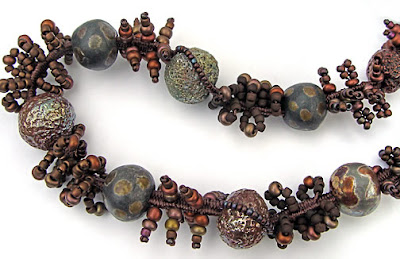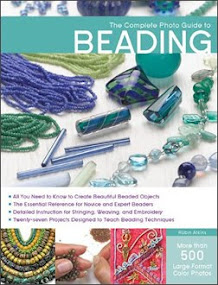 Recent Finger Weaving Projects
Recent Finger Weaving ProjectsI feel like I've been on another planet for about a month. Almost all my attention was devoted to the Bead Journal Project. But for one weekend, I took a happy break and went to a bead retreat with some beading buddies! There I worked on (and finished!) some new finger weaving projects.
The reason why the tassel on the right looks a little like a jelly fish, is because the top lampwork bead reminded me of a jelly fish from the moment I saw it. I think the maker, Jenny Friske-Baer (of Portland, OR), intended these beads to be flowers. They'd be lovely that way too.

Here's a closer look at the top of the tassel.
I had quite a lot of beads left over from the tassel, so next I used the finger weaving technique to make a multiple strand bracelet. The weaving is used at the ends to make the loop and clasp.

After that, I went to work on a necklace using some beads made by Alicia Kawano Oh, a lovely creator of raku-fired ceramic beads. I met Alicia while teaching in Honolulu years ago. Here's a picture showing the results!

You Can Learn Finger Weaving
Finger weaving is actually easy to learn, yet it has endless possibilities for design, depending on the cord and beads used. I've been doing it for about 15 years, and a year ago published a book with step-by-step instructions and design variations.
I also teach this technique, because I know it's always great fun to work directly with a teacher. Although I'm winding down my teaching career, you still have 2 opportunities to learn this fabulous method for making bracelets, necklaces, tassels and straps in a workshop environment. Both are comming right up:
Chicago, IL ~ June 26 and 27
Woven Treasure Necklace ~ two day workshop
North Suburban Needle Arts Guild
contact: Rhonda Newman ~ 847-564-4357
Woven Treasure Necklace ~ two day workshop
North Suburban Needle Arts Guild
contact: Rhonda Newman ~ 847-564-4357
My Chicago class is very small, so if you can do it, you're guaranteed lots of individual attention. Because it's a 2-day workshop, you'll learn many advanced techniques.
The Puget Sound Bead Festival in Tacoma is a fabulous event with great classes and great vendors. Smaller and more personal that the Bead & Button Show, it offers many perks for students. My finger weaving class there is filling, but still had openings the last I heard.
About Beading Cord for Finger Weaving
For almost all of my finger woven pieces, I use #18 bonded nylon cord, although linen and other materials are OK too. A person who has my book, Beaded Treasures, wrote to me recently to ask about C-Lon. Here's what I've learned so far.

There seem to be a good many put-ups for #18 nylon cord! (See picture above.) Sold in bead shops for macrame, this cord is also good for stringing and for finger weaving.
The spool on the left (A) is manufactured by Mastex and distributed to bead shops under the trade name of BeadSmith. This is what I've been using for finger weaving for 15 years. It's also what I sell on my website (here). Mastex used to put-up their cord on large spools (D), and a few suppliers still have stock of Mastex cord in this form.
I don't know who manufactures the larger of the two purple spools (B). It's slightly heavier than Mastex cord. It works OK and comes in this beautiful, rich purple color, which Mastex doesn't make. So I use (and sell) it too.
The other two spools (C and E) are now being offered by many bead shops. I've seen them referred to as either S-Lon and C-Lon, which is confusing. I don't know who is the actual manufacturer of this cord. Whoever it is also manufactures a much lighter weight cord, used for beadweaving and bead embroidery (similar to Nymo D). If you decide to try this cord for finger weaving, be sure you are getting the heavier weight!
One advantage of these smaller spools (C-Lon or S-Lon) is that they come in many luscious colors, and are sometimes packaged as sets with 3 to 12 colors/set. Because the put-up is smaller than Mastex cord (A and D), it's less expensive and you're not buying more than you need. It is very similar in all other respects to Mastex.
The disadvantage of these smaller spools is that the cord is stiff and holds the curls from being wound on a relatively small diameter spool. This makes it tangle when you're working with it.

Tip for Getting Rid of Tangles
Iron the cord! Measure off what you need. Heat up your iron to medium heat. Lay the cord over the ironing board and put the iron down on top of it. Leaving the iron in place, pull the cord slowly, ironing the entire length. It just straightens it right out... no more tangles!















